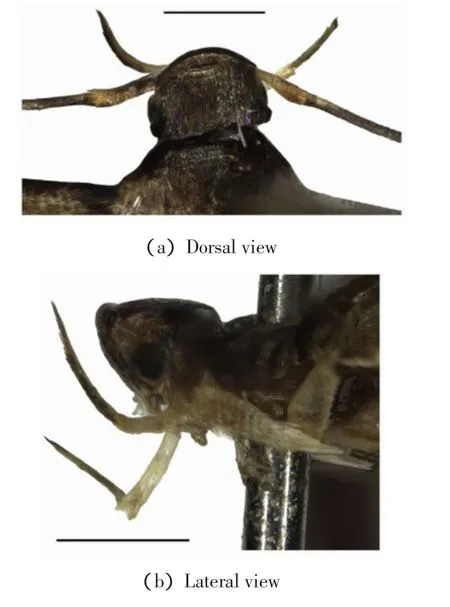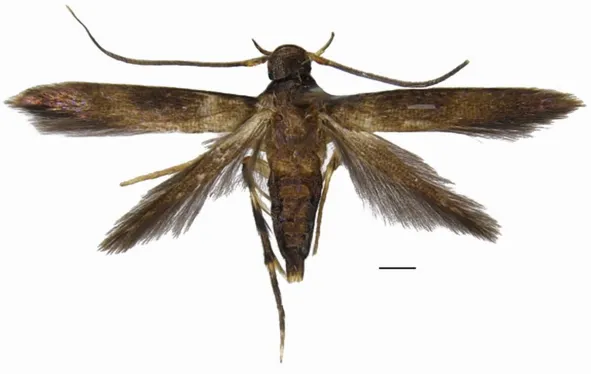Cuprina Sinev(Lepidoptera:Stathmopodidae)new to China,with description of a new species
GUANWei
(Collegeof Life Sciences,Nankai University,Tianjin 300071,China)
Cuprina was established by Sinev in 1988 for two Russian species[1-2],namely Cuprina fuscella Sinev,1988,the type species,and C.flaviscapella Sinev,1988.This paper newly records the genus Cuprina in China,and adds a new species Cuprina purpurata sp.nov.to science based on one specimen collected from Xizang,China.The studied specimen is deposited in the Insect Collection,College of Life Sciences,Nankai University,Tianjin,China.
Cuprina Sinev,1988
Cuprina Sinev,1988,Trudy Zoologicheskogo Instituta,178:122.
Type species:Cuprina fuscella Sinev,1988.
Generic characters.Head (Fig.1)smooth;face strongly slantingbackward,vertex with a transverse fillet,occiput flat,about 2.3 times length of eyes’diameter,with longitudinally lined scales.Eyes flat.Antenna with scape elongate,deeply concave at base on ventral margin;flagellum in male stouter than that in female.

Fig.1 Head of Cuprina purpurata sp.nov.(Scales=0.50 mm)
Labial palpus(Fig.1(b))upcurved,third segment about the same length as second segment.Maxillary palpus extremely short.Forewing narrow lanceolate,ground color usually with cupreous metallic luster.Venation:forewing with R1arising from before upper angle of cell,R4and R5stalked shortly,M1absent,M2indistinct at base,M3and CuA1arising from lower angle of cell,1A+2A not furcate.Hindleg(Fig.2)with dense tuft of bristles,tibia with a tuft of long bristles dorsally from basal 1/4 to middle,mid spurs located at basal 1/4,apical spurs located at apex;tarsus with wholes of short bristlesat apex of each segment.

Fig.2 Hind leg of Cuprina purpurata sp.nov.(Scale=0.50 mm)
Abdomen(Fig.3)with 2-7 segments in maleand 2-6 segments in female lined with spines that form a narrow arched band near posterior margin.Male genitalia with cucullus developed;aedeagus stout,usually bottledshaped.Female genitalia with ductus bursae shorter than corpus bursae, corpus bursae with signum, ductus seminaliswith clustered or scattered teeth at base.

Fig.3 Abdomen of Cuprina purpurata sp.nov.(Scale=0.25 mm)
Diagnosis.Cuprina is characterized by the face strongly slanting backward,the forewing with cupreous metallic luster,and the hind tibia with a tuft of long bristles.It issimilar to Thylacosceles Meyrick,but can be distinguished by the hind tibia with mid spurs located at basal 1/4,and dorsally from basal 1/4 tomiddlewith a tuft of longbristles.However,in Thylacosceles,the mid spurs of the hind tibia are located at basal 1/3,and the dorsal tuft of the longbristles is from basal 1/3 tobefore apex.
Distribution.China(Xizang),Russia.
Cuprina purpurata sp.nov.
Description.Adult(Fig.4)with wingspan 8.5 mm.Head dark brown,with cupreous metallic luster.Antenna with scape elongate,yellowish brown;flagellum blackish brown.Labial palpus yellowish white,third segment covered with dark brown on ventral surface.Thorax and tegula dark brown,shining.Forewing deep yellowish brown,distal 1/3 with purplish cupreous luster;with a large ill-defined blackish brown patch from between costal 1/4 and 3/5 to above fold;cilia dark brown.Hindwing brown,cilia deep grey.Fore-and midlegs pale yellow,tibia of foreleg with black spots at base on outer surface;tibia of midleg black in basal 1/3 and distal 1/3.Hindleg with femur pale yellow;tibia blackish brown,with long purplish brown bristles in basal 1/4 dorsally,ringed with silvery white and bearing white bristles from basal 1/4 to 1/3,with longpurplish brown bristles from basal 1/3 to1/2,forming a large tuft of bristles,with wholes of yellowish brown bristles apically,mid spurs located at basal 1/4,apical spurs located at apex of tibia;tarsus blackish brown,with short yellowish brown bristles at apex of each segment.Abdomen blackish brown on dorsal surface,2-6 segments in female lined with ocherous spines near posterior margin;ocherousyellow on ventral margin.

Fig.4 Habitus(adult)of Cuprina purpurata sp.nov.(Scale=0.50 mm).
Female genitalia (Fig.5).Papila analis with dense setae,rounded caudally.Apophysis posterioris about 1.5 times length of apophysis anterioris.Membrane between papilla analis and eighth segment slightly longer than papilla analis.Eighth sternite and tergite straight posteriorly,with long setae.Eighth sternite with anterior 1/5 protruding trapezoidally,eighth tergite straight anteriorly.Seventh sternite with two tufts of dense scales on inner surface,posterior 1/3 protruding triangularly;seventh tergite straight on posterior margin.Antrum subrectangular,width about four times length.Ductus bursae nearly uniform,about same length of corpus bursae.Corpus bursae rounded;signum located near posterior margin of corpus bursae,elliptical,scobinate,with a sclerotized transverse ridge medially.Ductus seminalis arising from ductus bursae anteriorly,broad at base,with a cluster of teeth at base,medial portion with densegranules,abruptly thinned distally.
Male unknown.

Fig.5 Femalegenitalia of Cuprinapurpurata sp.nov.(Scale=0.25 mm)
Type material.China:Holotype♀,Beibeng Town(95°12′E, 29°14′N), Motuo County, Tibet Autonomous Region,780 m,12-Ⅷ-2003,leg.Wang Xinpu and Xue Huaijun,genitalia slideno.GW13054.
Diagnosis.This new species is characterized by the seventh sternite with two tufts of scales on the inner surface and posterior 1/3 protruding triangularly in the female genitalia.It can be easily distinguished from C.fuscella by the forewing with distal 1/3 tinged with purplish cupreous luster;in C.fuscella,the forewing is entirely cupreousbrown.It can also be distinguished from C.flaviscapella by having a subrectangular antrum,which isbowl-shaped in C.flaviscapella.
Distribution.China(Xizang).
Etymology.The specific name is derived from the Latin purpuratus(=purple),referring to the forewing with distal 1/3 tinged with purplish cupreous luster.
[1]SINEV SY.A review of bright-legged moths(Lepidoptera,Stathmopodidae)in the fauna of the USSR[J].Trudy Zoologicheskogo Instituta,1988,178:104-133.
[2]LER P A.Key to the Insects of Russian Far East.Vol.5.Trichoptera and Lepidoptera.Pt 2[M].Dalnauka:Vladivostok,1999.

